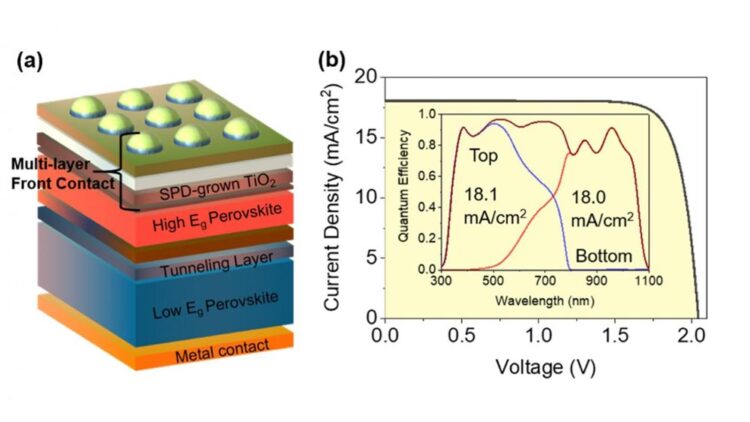An industrially viable competitor to silicon-based solar cells is in the works

(a) Schematic diagram of the perovskite/perovskite tandem solar cell, and (b) current-voltage characteristic curves of the best-investigated perovskite/perovskite tandem solar cell. Inset shows quantum efficiency for top perovskite and bottom perovskite.
Credit: Kanazawa University
Researchers from Kanazawa University fabricated a highly efficient perovskite solar cell with nearly the energy conversion efficiency of commercial silicon-based solar cells, which can be produced on a large scale.
Solar cells are excellent renewable energy tools that use sunlight to drive an electrical current for power. They’ve been used to power homes since the 1980s, and their performance and production cost have improved dramatically since then. The most common solar cells, based on silicon, work well for a long time. They retain more than 80% of their functionality even after 25 years. However, the efficiency–i.e., how much of the incoming sunlight is converted to electrical power–of commercial-scale silicon solar cells is currently only around 20%.
Maximizing solar cells’ energy conversion efficiency will improve their competitiveness compared to fossil fuels and help optimize them as a sustainable energy source. Researchers have intensively focused on an alternative to silicon: perovskite materials to enhance solar cells’ efficiency. Designs based on such materials must meet certain requirements, such as ease of fabrication on a large scale, and minimize reflected–i.e., wasted–light.
In a recent study published in Nano-Micro Letters, researchers from Kanazawa University applied a thin metal oxide film–reproducible, uniform, and compact–onto a perovskite solar cell. The researchers used a combination of lab work and computational studies to evaluate their solar cell design performance fairly.
“We used spray pyrolysis to deposit a front contact layer of titanium dioxide onto a perovskite solar cell,” explains Md. Shahiduzzaman, lead and corresponding author. “This deposition technique is common in the industry for large-scale applications.”
Upon finding an optimum thickness for the front contact layer, the researchers measured an energy conversion efficiency of 16.6%, assuming typical sunlight conditions. As mentioned, this isn’t quite as good as commercial silicon-based solar cells. Nevertheless, electromagnetic simulations were a powerful tool for predicting the possible energy conversion efficiency limit by optimizing specific parameters.
“Computational simulations suggest that the energy conversion efficiency of perovskite/perovskite tandem solar cells could go beyond 30% by a multi-layer front contact,” says Md. Shahiduzzaman, lead and corresponding author. “This is close to the theoretical efficiency limit of silicon-based solar cells.”
Additional challenges remain. For example, there must be a clear demonstration that the researchers’ solar cells continue functioning at least as long as silicon-based analogs. In addition, the perovskite solar cells are based in part on lead, a highly toxic metal. Ideally, there should be a clear protocol for recycling the devices instead of simple–and dangerous–disposal. Shahiduzzaman is optimistic that such technical challenges can be overcome with a focused research effort.
All latest news from the category: Power and Electrical Engineering
This topic covers issues related to energy generation, conversion, transportation and consumption and how the industry is addressing the challenge of energy efficiency in general.
innovations-report provides in-depth and informative reports and articles on subjects ranging from wind energy, fuel cell technology, solar energy, geothermal energy, petroleum, gas, nuclear engineering, alternative energy and energy efficiency to fusion, hydrogen and superconductor technologies.
Newest articles

Innovative 3D printed scaffolds offer new hope for bone healing
Researchers at the Institute for Bioengineering of Catalonia have developed novel 3D printed PLA-CaP scaffolds that promote blood vessel formation, ensuring better healing and regeneration of bone tissue. Bone is…

The surprising role of gut infection in Alzheimer’s disease
ASU- and Banner Alzheimer’s Institute-led study implicates link between a common virus and the disease, which travels from the gut to the brain and may be a target for antiviral…

Molecular gardening: New enzymes discovered for protein modification pruning
How deubiquitinases USP53 and USP54 cleave long polyubiquitin chains and how the former is linked to liver disease in children. Deubiquitinases (DUBs) are enzymes used by cells to trim protein…



